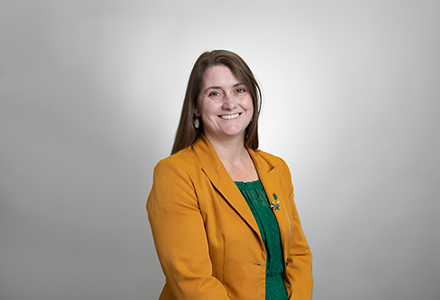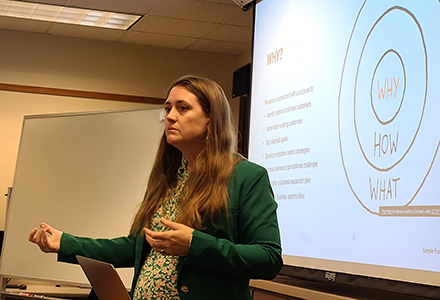“In a small community if you know the local paper, you probably know the journalists,” said Dr. Mildred “Mimi” Perreault, assistant professor in the Zimmerman School of Advertising & Mass Communications in the USF College of Arts and Sciences (CAS).

Dr. Mildred “Mimi” Perreault. (Photo by Corey Lepak)
Perreault and her colleagues have explored how rural journalists must balance professional responsibility and the increasing influences and demands of public relations (PR) when reporting in their communities.
Their findings, “’Everything Else is Public Relations’ How Rural Journalists Draw the Boundary Between Journalism and Public Relations in Rural Communities,” has been published in Mass Communications and Society.
The research was a national collaborative effort involving the support of academics including Jessica Fargen Walsh from University of Nebraska, Louisa Lincoln at the University of Pennsylvania, Dr. Ruth Moon at Louisiana State University, and a fellow Zimmerman School faculty member Dr. Gregory Perreault.
Perreault, who joined CAS in 2023, previously worked in journalism and public relations in Texas, Florida, and Washington, D.C. before pursuing a PhD in journalism from the University of Missouri in Columbia.
Perreault’s research on the interactions between public relations and journalism has actively contributed to the mass communications field for the past decade. Her latest publication delves into the unique relationship dynamic that exists between rural journalists and public relations practitioners, a topic that has not been fully explored.
“To provide some context, there aren't a whole lot of people studying local journalists, and most of these newspapers are very small. Many of them do have digital sites and are printed, but it’s usually just one or two journalists doing the work of a whole newsroom,” Perreault said.
To gain an understanding of the working practices of these rural journalists, Perreault and her team selected journalists from across the United States.
“We interviewed several journalists about how they interpret information from PR. We asked questions such as, what does that interaction look like for them? What kind of challenges do they face navigating the boundaries of journalism and PR? How do they incorporate PR strategies when trying make decisions for their communities?” she said.
Researchers tend to make clear distinctions between journalism and PR, but Perreault explored how the relationship between these two fields is much more complex and interconnected than traditionally believed.
The study took place during the pandemic, leading Perreault and her team to conduct remote interviews with the journalists via Zoom. The data gathered during the research process revealed substantial collaboration between the journalists and PR practitioners.
“Industry wide, it is known that journalists have a professional standard in which they produce information by and emphasize a non-biased opinion. Similarly, PR practitioners are expected to abide by the Public Relations Society of America Code of Ethics but are often influenced by individual perspectives,” Perreault said. “However, we sometimes see PR content run in local news organizations without any context.”
For example, Perreault recalls how information was relayed during the pandemic. A lot of health information was coming out of the U.S. government and hospital systems, and rural journalists relied on PR practitioners to share that information with them. Given the urgency, journalists often published this information without verifying it themselves. This is just one-way journalists have become more dependent on PR practitioners to share important and accurate information.

Dr. Mimi Perreault talks about her research to undergraduates in the Zimmerman School of Advertising and Mass Communications. (Photo courtesy of Vidisha Priyanka)
“This kind of communication is referred to as the facilitative role of journalism, which is the exchange of ideas between journalists and PR practitioners during times of crisis and disaster,” Perreault explained.
Perreault shared that in her previous research, she has focused on how news organizations share information during crises. Her research has often revealed gaps in the mass communication field when it comes to rural communities and the interpretation of complex topics. She has found that during these times, people are usually overloaded with information and left with the task of filtering through what they deem to be the most trustworthy. Addressing these gaps becomes the responsibility of journalists as they strive to deliver information that empowers people and enables actionable responses.
“With our research around crisis and disaster, even with local journalism, I feel like this is a hole in our field because a lot of journalism and mass communications research has focused on large databases of information rather than actual lived experiences,” Perreault said. “As a former journalist and PR practitioner myself, I find it's very useful to have that research and interview expertise that I gained during my career and be able to use it in how I present information to others.”
Acknowledging the intricate challenges rural journalists face, Perreault hopes that this work will contribute to an improved relationship between journalism and PR. Her goal is to empower rural journalists to offer reliable information to their communities by working together with PR practitioners.
“During the editing process, several journalists cited a quote from Geroge Orwell, ‘Journalism is printing something that someone else does not want printed; everything else is public relations.’ I think it's interesting how we’re deconstructing that topic a little bit in the article by asking what journalism and public relations really is? Where does one end and the other begin? The relationship between those two fields needs to be transparent. In smaller communities, journalists and PR practitioners rely on each other to communicate with the community they serve by sharing information the right way,” Perreault said.
Perreault’s academic and professional experiences have also given her the opportunity to serve nationally on the board of directors for the Association for Education in Journalism and Mass Communication (AEJMC). She’s also collaborated with the Commission on the Status of Women, an organization within AEJMC that advocates for women in media and communication and media education.
She plans to continue her research and is releasing a book in collaboration with Dr. Sarah Smith-Frigerio from the University of Tampa. The book is set to be released in early 2024 and will cover topics related to communication during the COVID-19 pandemic. Perreault and another colleague Dr. Katie Foss, at Middle Tennessee State University, recently published a study titled, “Parents’ News Consumption and COVID Sources in Their Decisions to Vaccinate,” about parents and where they source information about COVID-19.